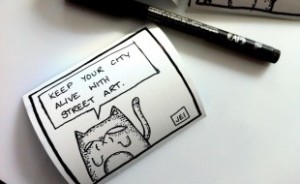Being an active citizen is a challenge in itself; so undoubtedly those who choose to be active for life will be exposed to many struggles along the way. How exactly does such a passion affect a person’s mental health? To what extent do they use their accomplishments to measure their self-worth?
These are questions that surround the memory of Tooker Gomberg, a Canadian political activist well-known for his contributions in the areas of social justice and environmental responsibility, as well as his unique methods of self-expression. Shortly after making a move from Toronto to Halifax later in his career, Gomberg lost a battle with depression and ended his life at Halifax’s MacDonald Bridge.
The way Gomberg’s life ended, suddenly and abruptly, following a struggle, is reflective of the overall theme of his life. Sudden change, incorporating struggle, were concepts directly integrated into Gomberg’s journey. Whether these lifestyle choices helped generate the consequences which ended his life, is questionable.
Activism without boundaries
Gomberg’s political career and activist movements are deeply associated with his memory. According to Angela Bischoff, his life partner of 17 years, Gomberg had his first taste of civil disobedience in the late 1970’s, when he got engaged in anti-nuclear organizing. From there, he became involved in bicycle advocacy and urban sustainability, using a wide array of techniques to capture the public’s attention when delivering his messages.
“He was an exceptional communicator and could always give a good interview,” said Bischoff in a recent phone conversation. “All of our events used humor, like puppets and costumes. Those illustrated our issues in a very visual way. We were skillful at making those events interesting and dynamic so the media would always pick up on them….but it was never enough for him to just oppose, he had to propose what he thought was a better solution. He was a good writer and researcher, very concise but colorful in his language. People were always attracted to his style of writing and way of communication.”
Bischoff currently still maintains the website Greenspiration, which showcases her work as well as Gomberg’s. Information on the website explains Gomberg was very passionate about a broad variety of issues, including clean transportation (bicycles), composting and recycling, air pollution, energy conservation and social justice.
“He was really good at creating media attention around the issues that were important to us,” says Bischoff. “We still weren’t very powerful in terms of shifting the decision makers, so he started getting actively involved in politics. He ran (for city council) a few times and got elected in 1992. Then the issues became much broader.”
Gomberg’s political career also saw many ups and downs. During the three years he spent on Edmonton City Council, he succeeded in influencing council’s decisions regarding water conservation, the establishment of a number of environmental advisory boards, research on
solar energy and several other environmentally oriented projects. He ran for Mayor of Toronto in the year 2000, losing the election but still gaining the support of 51,063 voters.
When Gomberg returned to activism following the Toronto election, he employed some of the boldest techniques in Canadian political history for raising awareness and generating engagement. According to Greenspiration, Gomberg burned his passport in protest of Canada’s withdrawal from the Kyoto Accord during a trip to the Netherlands in 2000. He was arrested during the World Petroleum Congress protests in Calgary the same year, and tear-gassed and arrested during the Free Trade Area of the Americas protests.
In 2002, Gomberg locked himself in a vault in Alberta Premier Ralph Klein’s office in an attempt to question the politician’s views on the Kyoto Accord. From inside the vault he faxed out handwritten press releases on Klein’s own letterhead, which eventually led to his arrest.
Understanding anti-depressants
Shortly afterwards, Gomberg and Bischoff moved to Halifax mainly for financial reasons. This is when Gomberg’s struggles with depression became especially critical.
“I received a job with the Ecology Action Centre, but he (Tooker) basically never got foothold,” said Bischoff. “He was engaged with the energy committee (at the Ecology Action Centre), but spiralled down into a pit of depression.”
Gomberg was given a prescription for Remeron, a commonly-used antidepressant. According to Bischoff, the pharmaceutical drug had more negative effects on Gomberg’s illness than positive.
“His depression was caused by many factors, but it was the drug that actually threw him over the edge of the bridge,” said Bischoff. “The prescribing physician didn’t prescribe him the right dosage and it drove him crazy and I witnessed that.”
According to Bischoff’s writings on Greenspiration, Gomberg began to experience suicidal thoughts for the first time ever after two weeks of taking the drug. The doctor’s response was to increase his dosage to the maximum amount. After approximately five weeks of taking the antidepressant, Gomberg’s bicycle and helmet were found on the MacDonald Bridge along with a suicide note. His body was never recovered.
“It was a big loss for the movement,” said Bischoff. “He was a driving force for the activism across the country, he fired up activist energy in all of the cities.”
It’s honourable to work to change the world, but do it in balance with other things. Explore and embrace the things you love to do, and you’ll be energetic and enthusiastic about the activism. Don’t drop hobbies or enjoyments. Be sure to hike and dance and sing. Keeping your spirit alive and healthy is fundamental if you are to keep going – Tooker Gomberg
Information provided on antidepressants on Health Canada’s website says the drugs can have serious side effects for some individuals. The website advises the family members of patients to closely monitor their behaviour after starting antidepressants, especially for “unexpected hostility, agitation or anxiety,” especially in the first few weeks after starting the drug.
Following Gomberg’s death, Health Canada moved to include information on harmful side effects and adverse drug reactions in product monographs. The one for Remeron can be found online in the drug product database. This information contains a warning for “potential association with behavioural and emotional changes, including self-harm.”
Embracing failure & celebrating success
Crystal Dieleman, PhD, is an assistant professor at Dalhousie’s School of Occupational Therapy. Her research is focused on forensic mental health and occupational science. Dieleman says its impossible to pinpoint any one particular thing as being the cause for suicidal behaviour.
“Prescribing medications for mental health concerns is an art as much as it is a science because everyone’s chemistry is different, everyone’s brain does not need or take up the same amount of dopamine…that’s why a lot of therapies don’t work, because we try to do it in a cookie-cutter fashion,” says Dieleman. “Information out there about (Tooker Gomberg) pinpoints the antidepressant and that the antidepressant itself led to the suicide. But there was an existing depression there anyways…I look at the life that he lived, which was remarkable, but fraught with things that can trigger or contribute to mental health problems.”
The stress caused by finances, impermanent living situations and workplace instability would have had an impact on Gomberg’s mental health.
“We’re pushing against the mainstream, and that has a whole set of challenges that can cause stress,” says Bischoff.
Bischoff now offers workshops on sustainable activism that focus on how to build a good support networks, restore energy and avoid long-term burnout.
“Another key element with activism is looking at these experiences of success and failure, or perceived successes and failures,” says Dieleman. “It’s better to look at the impact that he had on just getting issues out there and influencing what decision-makers and politicians did. You can see that years later looking back, but did he see that? In the moment, all you can see is that your effort didn’t get you what you wanted it to. It all depends on how he saw his own successes and failures – the things that were important to him.”
Gomberg’s accomplishments are still remembered today across the nation. In the years following his death, Toronto activists launched a “Take the Tooker” campaign, advocating for bike lanes on Bloor and Danforth Streets in downtown Toronto, to be named after Gomberg. A lengthy list of his written articles and achievements can also be found on Greenspiration, and he is of course remembered through the work of Angela Bischoff.
“Whether its the activist world, or the academic world, people struggle in various ways with the challenges that particular calling has,” says Bischoff. “We need to overcome them by supporting each other.”
See the impacts Tooker Gomberg had on our country. Click on the points for different important life events. You may need to zoom in on the cities to see all of the points (Source: Greenspiration.org).




Laura, it’s a lovely piece. I think it captures Tooker’s essence and his struggle. I appreciate you writing it, and sharing it with me. Peace…